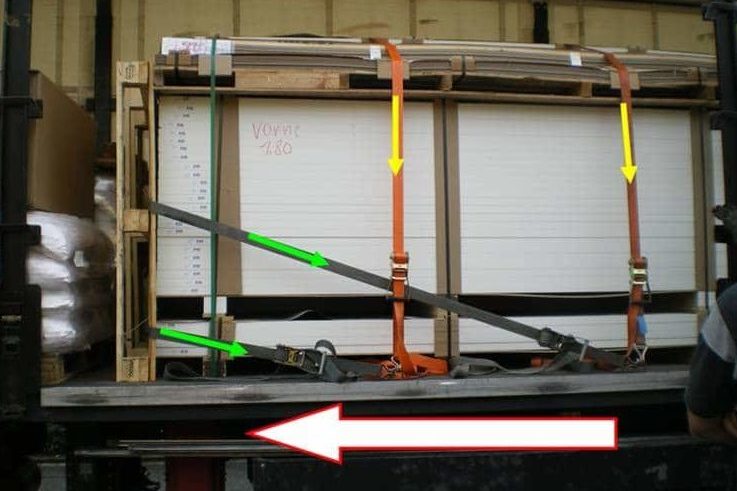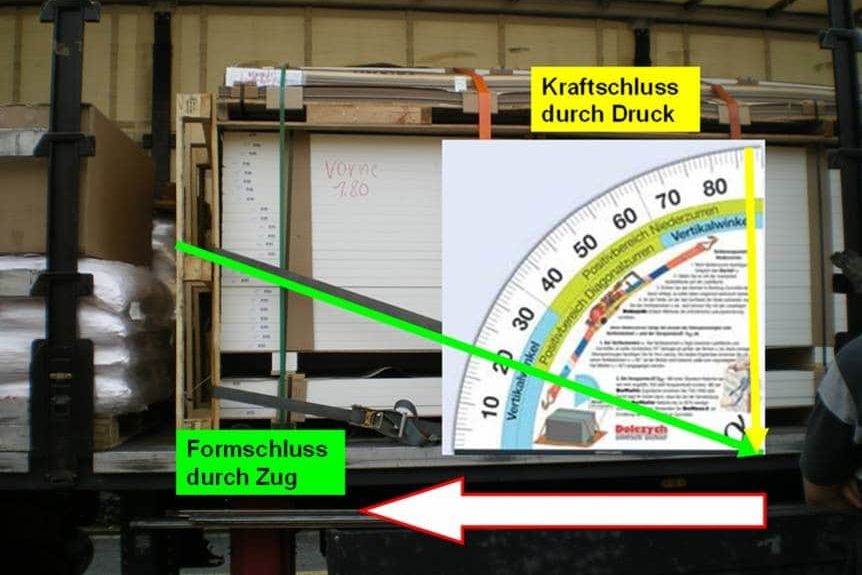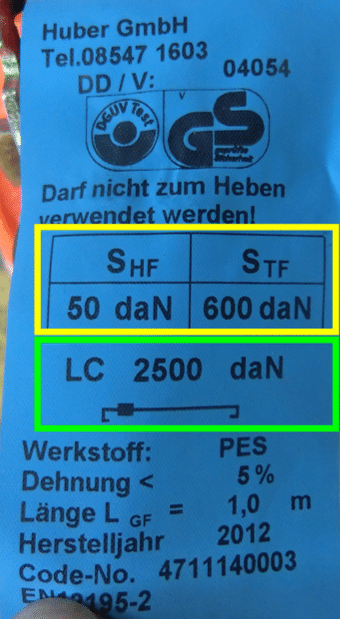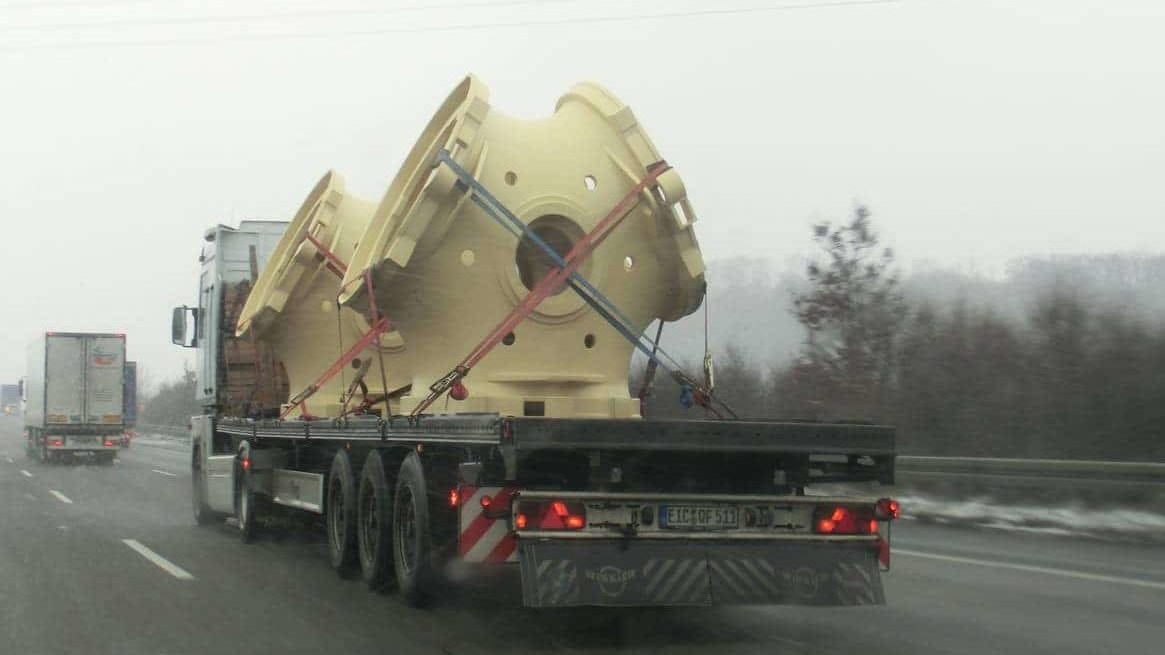
Now 10% off all Ergolash lashing straps save now! Voucher code: ergo10 | Valid until 31.05.2025
Load securing is an inexhaustible topic and anyone with a keen eye on the road has certainly recognized that more loads are being secured than in the past.
Even the agricultural sector is using more and more safety equipment. Whether they are effective, however, is questionable. Perhaps this can be described with the following anecdote.
Two mothers are talking about their musical children.
One says: my son plays the piano and yours?
The other says proudly: mine plays the piano too!
The first says: so, but he plays wrong.
The correct use of safety devices is what makes the measure effective. To do this, you have to understand what is actually happening.
Section 22 of the German Road Traffic Act (StVO) describes the conditions: “do not slip, fall over, roll back and forth, fall down or make avoidable noise, even when braking hard or taking sudden evasive action.”
This makes it clear that the load must not move parallel to the loading surface in the direction of travel in the event of emergency braking and must also not move parallel, but at right angles to the direction of travel in the event of evasive action. This movement must therefore be prevented by the securing devices.

If no securing devices are used, this movement is secured solely by the friction between the load and the loading surface. The measure of this friction is the coefficient of friction µ. And the cleaner the loading surface, the higher the coefficient of friction.
At this point, it is also important to explain the difference between frictional locking and positive locking using an example.
In the picture, the red arrow points in the direction of travel, which is also the direction in which the load would move in the event of emergency braking.

This partial load is secured with four belts, 2x yellow arrow, 2x green arrow.

The angles play a major role in all methods.
If a belt (yellow arrow) is attached at right angles (90º) to the possible direction of movement of the load, its pre-tensioning force increases the weight of the load due to pressure, resulting in a higher frictional force between the load and the loading surface. This is a frictional connection.
If, on the other hand, the angle (< 90º) changes towards 0º, the belt (green arrow) is increasingly subjected to tension during a load movement. Then we speak of positive locking.
If the lashing angle is greater than 0º but less than 90º, the securing force is divided into a form-fit and a force-fit component. The ratio changes at around 45º.
Tie-down lashing is a force-fit securing method, while bay lashing/head lashing and direct lashing are form-fit securing methods. It is also important to differentiate between the various details on a belt label.
The information outlined in yellow is to be used for lashing down. This belt can provide a securing force of 600 daN x 0.3 = 180 daN when lashing down with an assumed coefficient of friction of µ=0.3 (clean loading surface) and a lashing angle of 90º.
The information outlined in green must be used for direct lashing. In a straight pull, with an assumed lashing angle of 0º, the belt can provide a securing force of 2,500 daN.
With bay lashing/head lashing , this value increases to 5,000 daN, as the belt is hooked into two lashing eyes on the cargo bed. The limitation here is the load capacity of the lashing eyes. If these have a strength of 2,000 daN (standard), the securing force is reduced to 4,000 daN.

The prerequisites for a more precise explanation of bay lashing and head flashing are now in place.
Head flashing is an excellent method of securing a load to the rear. The upright pallets form a surface for better force transmission and also hold the belts in position. In the example on the right, an approximate securing force of 8,000daN can be assumed without taking the exact angles and friction into account.
However, the lashing angles must always be less than 45º in order to achieve the highest possible form-fit proportion of the securing force.

Example of head flashing.

Example of a cross lashing.
Cross lashing is a variant of head lashing and is easy to use with stable load units such as pallet cages. Pallets are not required in this case because the belts are positioned by the load itself.
The roughly calculated securing force is calculated by adding the LC of the lashing eyes used. In the example on the right, four standard eyelets with 2,000 daN each are used, i.e. a total of 8,000 daN. The belts must have an LC of > 2,000 daN.
The entire length should be used here, especially for the belt ends coming from above (yellow arrow), in order to achieve as flat an angle as possible.
Head lashing/cross lashing can also be used for a load that cannot be positioned against the end wall due to the load distribution. The application principle is the same.
Bight lashing is a method also known as loop lashing lashing and, like many cargo securing methods, comes from the maritime industry. A sling is first placed around the load and the ends of the sling are then attached to the means of transportation.
The picture clearly shows the belt guide on a load. As with head lashing, the LC of the straps and the lashing eyes is crucial.
The model shows the belt guide.

However, this method is only suitable for securing across the direction of travel and two belts must always work together.

Securing in the direction of travel can be achieved by positive locking.
With a little imagination, it is possible to find ways of securing machines and systems that come close to or even surpass the effect of direct lashing. This was also evident in the pictures.
Exceeding because the looped belt is hooked into two lashing eyes and thus the double LC can be used.
Yours, Sigurd Ehringer


Next post >>
Episode 7: The incoming inspection of the container

Sigurd Ehringer
✔ VDI-zertifizierter Ausbilder für Ladungssicherung ✔ Fachbuch-Autor ✔ 8 Jahre Projektmanager ✔ 12 Jahre bei der Bundeswehr (Kompaniechef) ✔ 20 Jahre Vertriebserfahrung ✔ seit 1996 Berater/Ausbilder in der Logistik ✔ 44 Jahre Ausbilder/Trainer in verschiedenen Bereichen —> In einer Reihe von Fachbeiträgen aus der Praxis, zu Themen rund um den Container und LKW, erhalten Sie Profiwissen aus erster Hand. Wie sichert man Ladung korrekt und was sind die Grundlagen der Ladungssicherung? Erarbeitet und vorgestellt werden sie von Sigurd Ehringer, Inhaber von SE-LogCon.
Rothschenk assortment
Our customer center has only one goal: to turn your problems into solutions. Whether standard stowage cushions, bestsellers or load securing personally tailored to your needs -. we accompany you consistently from A as in field service to Z as in certification. That is our promise to you, as a leader in our industry.
We attach great importance to professional cargo securing. That is why we have our own production, which ensures reliable operation through modern manufacturing technologies and strict quality control. Thus, we offer our customers a comprehensive and high-quality range of services in the field of transport logistics.
DIN ISO 9001:2015, EMAS and Ecovadis are not foreign words to you? Then it's time to work with the best.
You don't take any risks with us - we have been awarded the Platinum Medal on the EcoVadis sustainability rating platform.
As a load securement company, we are proud to have several certifications that validate our sustainability efforts and our commitment to environmental protection and social responsibility. For you as a purchaser, this means that we demand and promote the implementation of high environmental and social standards both within the company and along the supply chain.
>WHITE LINES AND RED LINES
— Product category
For orders over €50
Valid until October 31, 2025
You are currently viewing a placeholder content from Google Maps. To access the actual content, click the button below. Please note that doing so will share data with third-party providers.
More Information